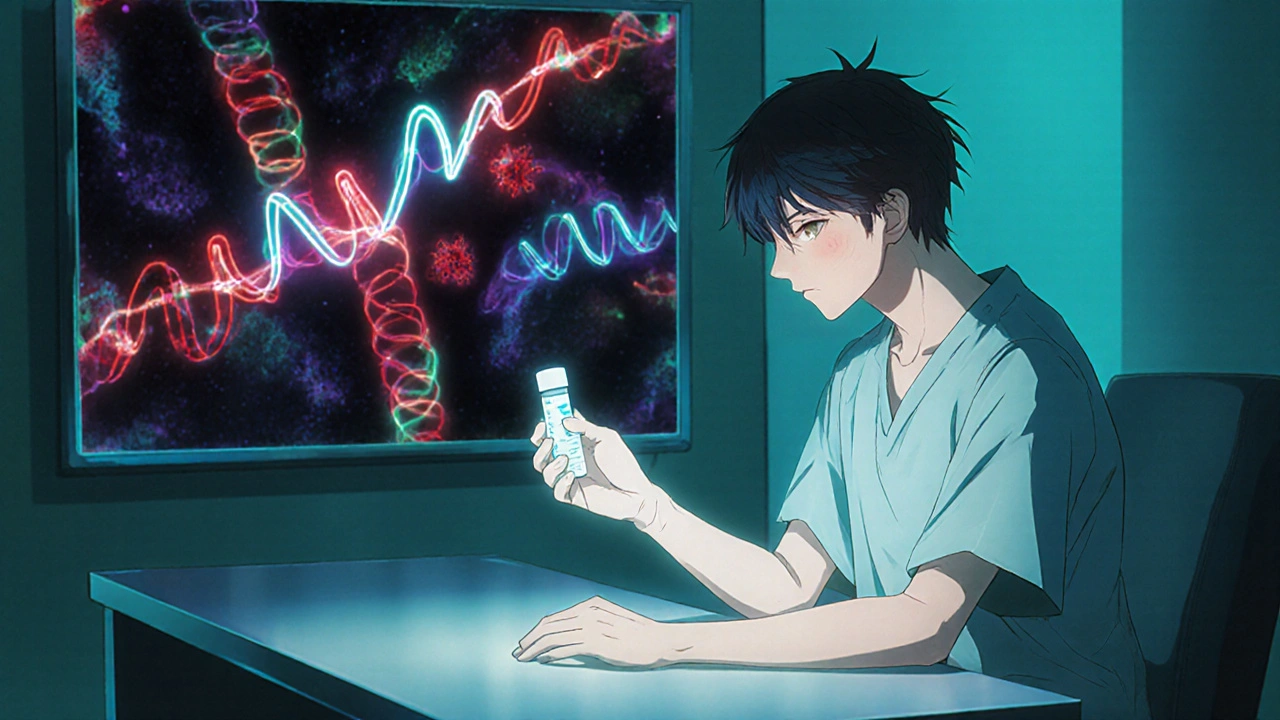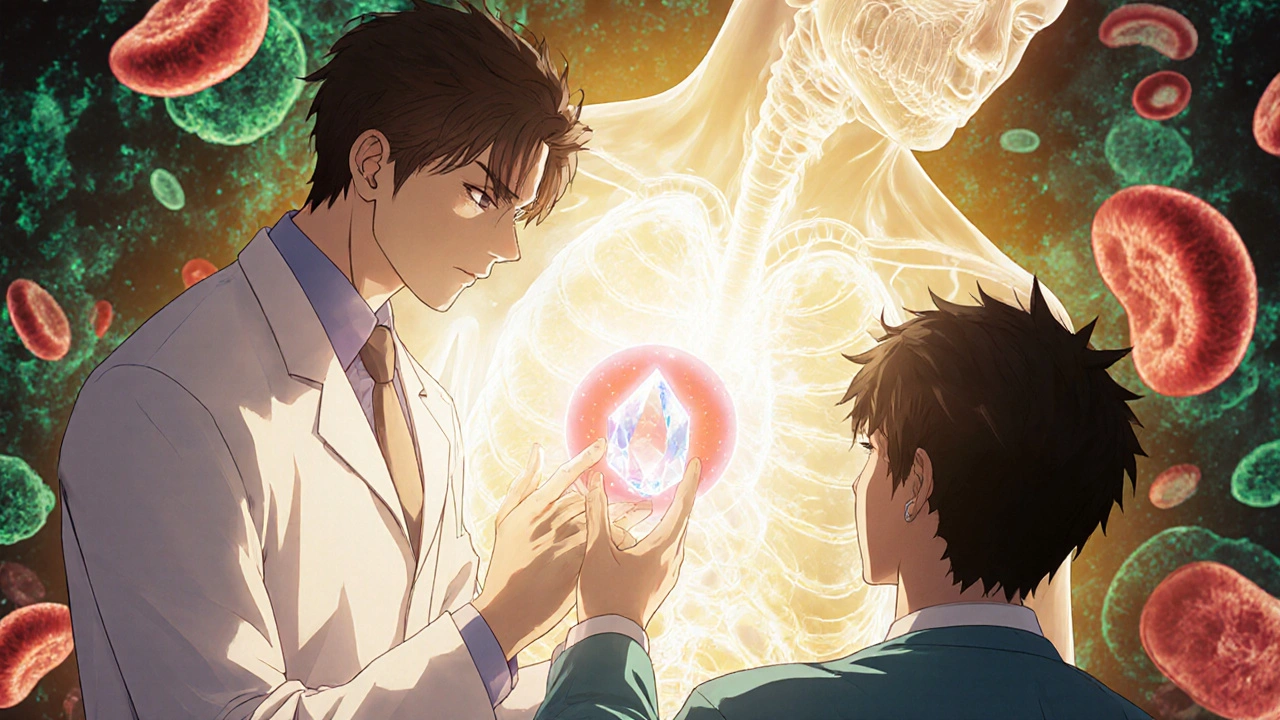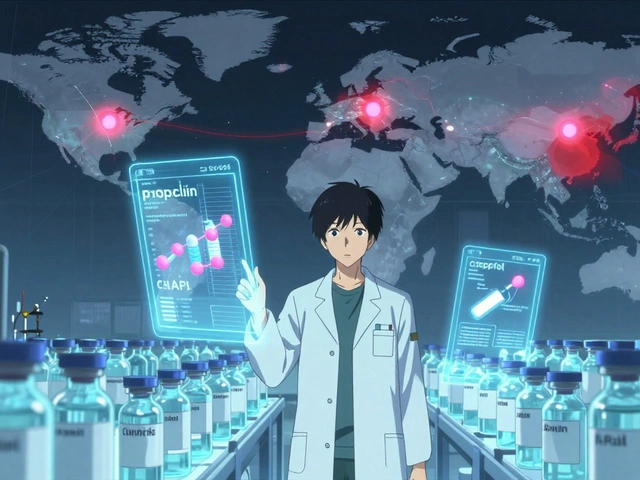When you hear the terms leukemia is a group of cancers that begin in the bone marrow and disrupt normal blood cell production and bone marrow disorders are conditions that impair the marrow’s ability to make healthy blood cells, it’s easy to think they’re unrelated problems that just happen to share the word “marrow.” In reality, they’re two sides of the same coin. This guide untangles how they interact, why some disorders turn into leukemia, and what that means for diagnosis and treatment.
Key Takeaways
- Leukemia originates in the bone marrow, so any disorder that harms marrow function can increase leukemia risk.
- Myelodysplastic syndromes (MDS) and aplastic anemia are the most common marrow conditions that progress to acute leukemia.
- Cytogenetic abnormalities and stem‑cell mutations are the molecular bridges linking the two groups.
- Early detection through blood counts and bone‑marrow biopsies can catch malignant transformation before symptoms worsen.
- Treatment often overlaps-chemotherapy, targeted therapy, and stem‑cell transplant address both the cancer and the underlying marrow defect.
What Is Bone Marrow and How Does It Work?
Hematopoiesis is the process by which bone marrow produces red cells, white cells, and platelets. The marrow houses multipotent stem cells that differentiate into specific lineages under the guidance of growth factors and cytokines. When this balance is disturbed-by genetic mutations, chemical exposure, or autoimmune attack-the result is a bone‑marrow disorder.
Common non‑cancerous marrow problems include:
- Aplastic anemia: the marrow shuts down, leading to low blood counts.
- Myelofibrosis: scar tissue replaces healthy marrow, reducing cell output.
- Myelodysplastic syndromes (MDS): abnormal cells develop but don’t fully transform into cancer, yet they can evolve into leukemia.
Understanding Leukemia
Leukemia is not a single disease; it’s a family of blood cancers that differ by cell type (myeloid vs. lymphoid) and speed of progression (acute vs. chronic). The two most common forms are:
- Acute Myeloid Leukemia (AML) is a fast‑growing cancer of myeloid cells that usually follows MDS or prior chemotherapy.
- Chronic Lymphocytic Leukemia (CLL) is a slower‑progressing disease of mature lymphocytes, often unrelated to marrow disorders but sometimes linked to underlying immune dysregulation.
The hallmark of all leukemias is the uncontrolled proliferation of immature blood cells that crowd out normal cells, causing anemia, infection risk, and bleeding.
How Bone Marrow Disorders Can Trigger Leukemia
Several mechanisms turn a benign marrow problem into a malignant one:
- Genetic Instability: Chronic stress on stem cells (as seen in aplastic anemia or MDS) creates DNA breaks. Over time, these errors accumulate, producing oncogenic mutations.
- Cytogenetic Abnormalities: Translocations like t(8;21) or deletions of chromosome 5q are common in MDS and are also driver events in AML.
- Clonal Evolution: A single mutated stem cell expands, forming a clone that can acquire additional hits, eventually crossing the threshold into leukemia.
In practice, patients with high‑risk MDS have a 30‑40% chance of progressing to AML within five years. Aplastic anemia patients who receive immunosuppressive therapy also carry an elevated risk, especially if they have a short telomere length.

Diagnostic Overlap: When Do Doctors Suspect Leukemia?
Because early leukemia can mimic a simple marrow failure, doctors rely on a combination of blood work and marrow examination:
- Complete blood count (CBC): Persistent drops in neutrophils, platelets, or hemoglobin raise red flags.
- Peripheral smear: The presence of blasts (immature cells) suggests acute leukemia.
- Bone‑marrow biopsy: Provides a tissue sample to assess cellularity, dysplasia, and genetic mutations.
- Cytogenetic testing: Fluorescence in situ hybridization (FISH) and next‑generation sequencing reveal the exact mutations driving transformation.
When the biopsy shows >20% blasts, the diagnosis shifts from MDS to AML, triggering a different treatment pathway.
Treatment Strategies That Address Both Conditions
Because marrow disorders and leukemia share root causes, many therapies target the common denominator-abnormal stem cells.
- Chemotherapy: Standard induction regimens (e.g., cytarabine plus anthracycline) aim to eradicate leukemic blasts but also clear abnormal marrow clones.
- Targeted agents: Drugs like azacitidine (a hypomethylating agent) are first‑line for high‑risk MDS and can delay AML onset.
- Stem cell transplant is the only curative option for many high‑risk marrow disorders and acute leukemias, replacing the patient’s defective marrow with healthy donor cells.
- Immunotherapy: Agents such as blinatumomab (a bispecific T‑cell engager) are approved for B‑cell ALL but are increasingly explored for AML with specific surface markers.
Choosing a regimen depends on age, comorbidities, and the specific genetic profile of the disease.
Risk Management and Monitoring
Patients with known marrow disorders should undergo regular surveillance:
- Quarterly CBCs to detect trending cytopenias.
- Annual bone‑marrow assessments for high‑risk MDS.
- Prompt evaluation of new symptoms-fatigue, bruising, or infections.
Early intervention, such as starting azacitidine before overt AML, improves overall survival by 15‑20% in recent clinical trials (2023‑2024 data).

Living with the Overlap: Lifestyle and Support
While medication is essential, patients can boost marrow health through:
- Balanced nutrition rich in iron, folate, and B12.
- Avoiding known marrow toxins-benzene exposure, excessive radiation, and certain chemotherapy agents unless medically necessary.
- Regular exercise to maintain cardiovascular fitness, which helps tolerate intensive chemotherapy or transplant.
Support groups (e.g., the Leukemia & Lymphoma Society) offer peer advice on navigating the emotional roller‑coaster of a dual diagnosis.
Comparison of Common Marrow Disorders That May Lead to Leukemia
| Disorder | Typical Age | Risk of AML | Common Cytogenetics |
|---|---|---|---|
| Myelodysplastic Syndromes (MDS) | 65‑75 | 30‑40% within 5 years | 5q‑, -7/7q‑, +8 |
| Aplastic Anemia | 20‑40 | 5‑15% (higher with telomere shortening) | None specific; may acquire -7/7q‑ after treatment |
| Myelofibrosis | 55‑70 | 10‑20% | JAK2 V617F, CALR, MPL |
Frequently Asked Questions
Can MDS be cured without progressing to leukemia?
There is no guaranteed cure for MDS, but low‑risk patients can live many years with supportive care. Early use of hypomethylating agents and, in select cases, stem‑cell transplant can prevent or delay AML transformation.
Is bone‑marrow biopsy painful?
A local anesthetic is injected, so most patients feel only brief pressure. Severe pain is rare, and the procedure usually takes 15‑30 minutes.
Do lifestyle changes lower the risk of leukemia in marrow disorders?
While no lifestyle change can eliminate genetic risk, avoiding toxic exposures, maintaining good nutrition, and staying active can support overall marrow health and improve treatment tolerance.
What is the role of genetics in predicting leukemia transformation?
Specific mutations-such as TP53 loss, complex karyotype, or RUNX1‑RUNX1T1-are strong predictors of rapid progression. Genetic testing is now routine in MDS work‑ups.
How does a stem‑cell transplant cure both conditions?
The transplant replaces the patient’s defective marrow with donor stem cells, eradicating the malignant clone and resetting normal blood‑cell production.
Understanding the link between leukemia and bone marrow disorders empowers patients and clinicians to catch dangerous changes early, choose the right therapy, and improve long‑term outcomes.









Taylor Nation
Really appreciate how the guide lays out the cascade from marrow stress to malignant clones. It's clear that chronic DNA damage in stem cells is the key driver, so monitoring patients with regular CBCs makes sense. The overlap in treatment-using hypomethylating agents for both MDS and early AML-shows how intertwined these diseases are.
Shermaine Davis
Great summary, very helful!
tatiana anadrade paguay
I think the piece does a solid job breaking down the genetics behind transformation. Mentioning specific cytogenetic hits like 5q deletions helps patients understand why labs matter. Also, the lifestyle suggestions, though not curative, give readers actionable steps they can actually follow.
Diane Larson
The relationship between marrow failure syndromes and leukemic transformation is something many patients hear about but never fully grasp.
The continuous stress on a stem‑cell pool creates DNA damage that can serve as a perfect storm for oncogenic hits.
That is why conditions like MDS or aplastic anemia carry a measurable risk of evolving into acute myeloid leukemia.
Early detection through periodic CBCs and marrow biopsies can catch clonal evolution before the blast count spikes.
Cytogenetic studies, especially looking for deletions on chromosome 5q or complex karyotypes, give us a molecular roadmap.
Targeted hypomethylating agents such as azacitidine have shown to delay AML onset in high‑risk MDS patients, buying crucial time.
For younger or fit patients, an allogeneic stem‑cell transplant remains the only curative option, resetting the hematopoietic system.
However, transplant comes with its own set of risks, including graft‑versus‑host disease, which requires careful monitoring.
Lifestyle tweaks-adequate B12, iron, and folate, plus avoidance of benzene-won't erase genetic risk but they support overall marrow health.
Support groups offer more than emotional comfort; they often share practical tips on managing infections during neutropenia.
The decision to start treatment early versus watchful waiting hinges on the patient’s age, comorbidities, and specific mutations like TP53.
Recent trials from 2023‑2024 suggest that intervening at a lower blast percentage improves overall survival by roughly 15‑20%. It’s also worth noting that not all leukemias arise from prior marrow disorders; CLL, for example, follows a different pathogenic route.
Still, the overlap in therapeutic strategies, such as using the same chemotherapy backbone for both AML and high‑risk MDS, underscores the biological connection.
In practice, a multidisciplinary team-including hematologists, genetic counselors, and transplant specialists-offers the best chance for optimal outcomes.
Michael Kusold
yeah, that was a lot of info-kinda feels like a textbook sometimes. but the part about early transplant really hit home for me. i wish more docs would push those check‑ups sooner.
Narasimha Murthy
While the overview is concise, it glosses over the heterogeneity among marrow disorders. The assertion that hypomethylating agents universally delay leukemic progression lacks nuance, especially in TP53‑mutated cases where responses are modest. A more rigorous appraisal of the data would strengthen the argument.
Samantha Vondrum
Excellent synthesis of the clinical and molecular aspects. The inclusion of recent trial data (2023‑2024) adds credibility. 🙏🏽 Moreover, emphasizing a multidisciplinary approach aligns with best practice guidelines. 🌟
Kelvin Egbuzie
Oh sure, let’s pretend every doctor reads dense journals before prescribing. 🙄 Meanwhile, patients are busy trying to survive the side effects. 😀
Katherine Collins
Nice read, learned a lot! :)